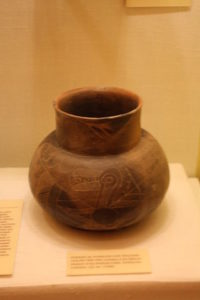
The woodpecker archaeological record in Europe is sparse. Woodpecker bones were found with other bird and animal bones at a Mesolithic site in Serbia and I found reference to an atlatl (a primitive spear throwing device) that had a decorative White-backed Woodpecker from an unspecified European site. Where the archaeological woodpecker record is rich is again in North America. Woodpecker skulls and bills were apparently traded. Woodpeckers are found on pottery and shell engravings. Of course, archaeologists in North America have contemporary Amerindians with tribal memories to help them interpret findings and ask the right questions. Some woodpecker designs are stylistic and might be missed without this insight. Another factor is that archaeology in North America typically goes back about a thousand years while Mesolithic Europe was ten thousand years ago. Finally, it should be considered that since pecking wood is the sine qua non of the woodpecker, effigies of the bird might have been carved in wood rather than more durable bone or stone.
